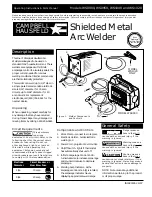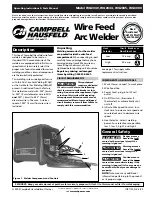
2.0 MIG/MAG Operating Manual
8
BOC Smootharc 180 Multiprocess operating manual
2.1 Introduction to Metal Inert Gas (MIG)
& Metal Active Gas (MAG)
MIG/MAG welding embraces a group of arc welding processes in which
a continuous electrode (the wire) is fed by powered feed rolls (wire
feeder) into the weld pool. An electric arc is created between the tip of
the wire and the weld pool. The wire is progressively melted at the same
speed at which it is being fed and forms part of the weld pool. Both the
arc and the weld pool are protected from atmospheric contamination by
a shield of inert (non-reactive) gas, which is delivered through a nozzle
that is concentric with the welding wire guide tube.
Operation
MIG/MAG welding is usually carried out with a handheld torch as a semi-
automatic process. The MIG/MAG process can be suited to a variety of
job requirements by choosing the correct shielding gas, electrode (wire)
size and welding parameters. Welding parameters include the voltage,
travel speed, arc (stick-out) length and wire feed rate. The arc voltage
and wire feed rate will determine the filler metal transfer method.
This application combines the advantages of continuity, speed,
comparative freedom from distortion and the reliability of automatic
welding with the versatility and control of manual welding. The process
is also suitable for mechanised set-ups, and its use in this respect
is increasing.
MIG/MAG welding can be carried out using solid wire, flux cored, or a
copper-coated solid wire electrode. The shielding gas or gas mixture may
consist of the following:
• Argon (MIG)
• Carbon dioxide (MAG)
• Argon and carbon dioxide mixtures (MAG)
• Argon with oxygen mixtures (MAG)
• Argon with helium mixtures (MIG)
Each gas or gas mixture has specific advantages and limitations. Other
forms of MIG/MAG welding include using a flux-cored continuous
electrode and carbon dioxide shielding gas, or using self-shielding flux-
cored wire, requiring no shielding.
2.2 Introduction to Flux Cored
Arc Welding (FCAW)
How it Works
Flux-cored arc welding (FCAW) uses the heat generated by a DC electric
arc to fuse the metal in the joint area, the arc being struck between a
continuously fed consumable filler wire and the workpiece, melting both
the filler wire and the workpiece in the immediate vicinity. The entire arc
area is covered by a shielding gas, which protects the molten weld pool
from the atmosphere.
FCAW is a variant of the MIG/MAG process and while there are many
common features between the two processes, there are also several
fundamental differences.
As with MIG/MAG, direct current power sources with constant voltage
output characteristics are normally employed to supply the welding
current. With flux-cored wires the terminal that the filler wire is
connected to depends on the specific product being used, some wires
running electrode positive, others running electrode negative. The work
return is then connected to the opposite terminal. It has also been found
that the output characteristics of the power source can have an effect on
the quality of the welds produced.
Typical MIG/MAG set up
Torch trigger
Welding wire
Weld
Weld pool
Torch
Shroud
Gas diffuser
Contact tip
Shielding
Droplets
Содержание 180 Multiprocess
Страница 1: ...180 Multiprocess Operating manual 6PRRWKDUF GYDQF GYDQF ...
Страница 45: ...45 BOC Smootharc 180 Multiprocess operating manual ...
Страница 53: ......
Страница 54: ......
Страница 55: ......









































